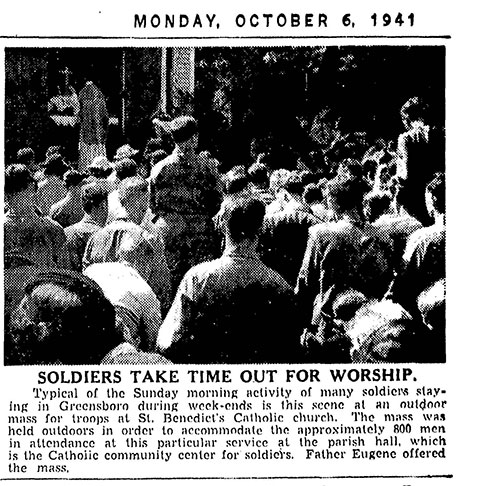Mass al fresco
 GREENSBORO — A holy anticipation grew to a crescendo May 10 as many North Carolina Catholics attended open-air Masses and received Our Lord in the Eucharist for the first time since pandemic restrictions began eight weeks prior.
GREENSBORO — A holy anticipation grew to a crescendo May 10 as many North Carolina Catholics attended open-air Masses and received Our Lord in the Eucharist for the first time since pandemic restrictions began eight weeks prior.
Greensboro’s Our Lady of Grace Church offered three outdoor Masses in English, Spanish and Latin. Individuals and families knelt in the grass six feet apart as they worshiped together for the first time since March 14. Tears started flowing as Franz Schubert’s “Ave Maria” filled the air in the familiar voice of Andrew O’Connor, the parish’s music director.
“People were elated, joyful and showing great piety,” O’Connor said. “I think this is going to bring a renewed vigor of people’s faith because they’ve been without the Eucharist for so long.”
As unusual as the current situation is, emotions ran high at open-air Masses in Greensboro once before. In the fall of 1941, the nation faced a different global crisis – the Second World War. As the
U.S. prepared to enter the conflict, Greensboro hosted thousands of troops on break from the rigors of mock warfare in Eastern North Carolina.
St. Benedict – Our Lady of Grace’s “mother church” – ministered to the Catholic troops offering hospitality and a multitude of outdoor Masses to accommodate crowds. The optics were starkly opposed to those on May 10, however. Several hundred servicemen huddled together to worship, and there appeared to be no limit on congregation size.
Greensboro native Monsignor Joseph Showfety, then 14, recently recalled the events. “They used the stoop for Mass, and the men would kneel on the same level as the hall or in the middle of the street,” he said.
“They (the police) blocked off Elm, Eugene, Greene, and the priest would say Mass outdoors, and people would sit out on front porches to watch the whole thing.”
Monsignor Showfety also noted that the pious soldiers caught the attention of many in the Protestant community, including a nearby Presbyterian minister who was so impressed with the young men’s midnight fast prior to Mass that he talked about it on the radio.
Spiritual warriors Benedictine Father Eugene Egan and Benedictine Father Cornelius Diehl offered the Masses as did Father James P. McLarney of Chicago and “The Catholic Hour” radio program. The church’s four-Mass schedule swelled to nine before it was all over, and an estimated 800 soldiers attended one service. A week later, there were about 2,000 troops at the Sunday Masses.
St. Benedict came of age in its wartime role, making a deep impression on people in Greensboro and across several states. With influence beyond its usual scope, the parish unified thousands and brought Jesus in the Eucharist to scores of servicemen, spiritually fortifying them before they headed into the bloodiest war in history. Today, this fortification is as crucial as ever.
— Annie Ferguson, Correspondent


